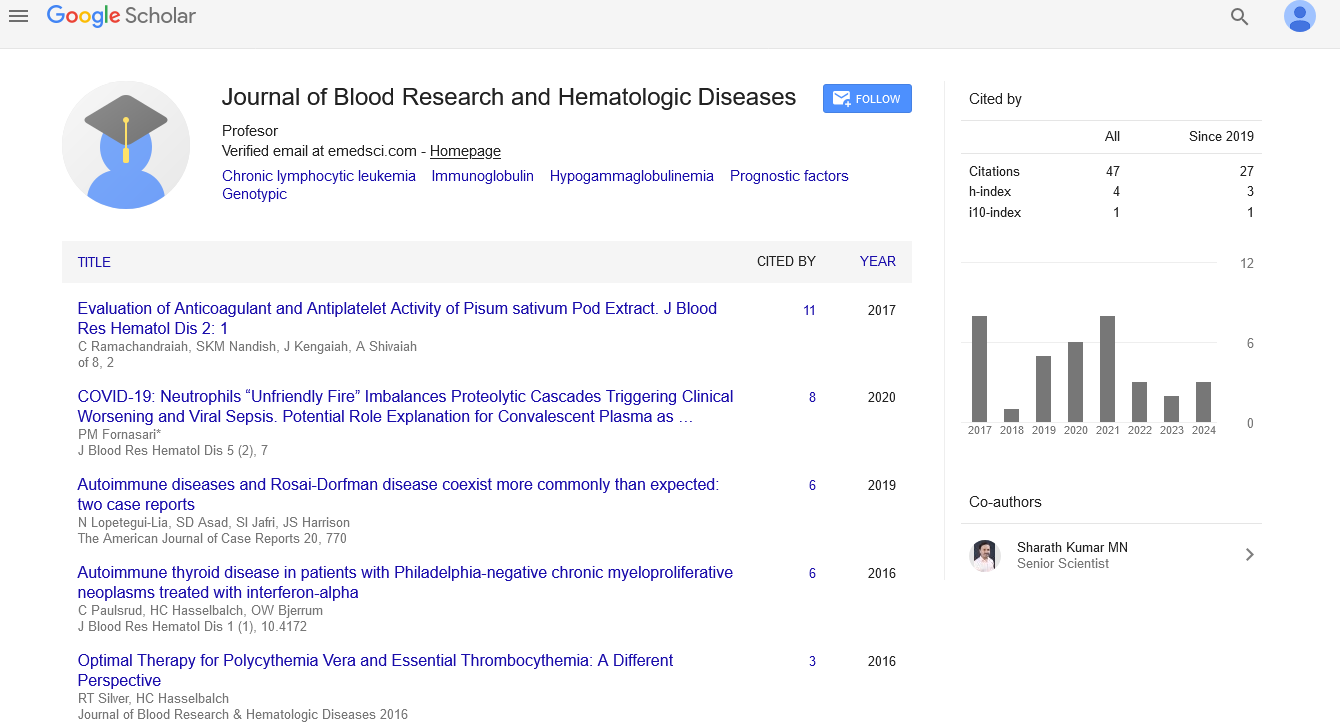Perspective, J Blood Res Hematol Dis Vol: 10 Issue: 1
Intricate Tubular Networks: Exploring the Pathways of Blood Circulation
Richtffery Avidgner*
Department of Molecular Medicine, University of Pavia, Pavia, Italy
*Corresponding Author:Richtffery Avidgner
Department of Molecular Medicine, University of Pavia, Pavia, Italy
E-mail:richtfferyavi@gmail.com
Received date: 24 May, 2024, Manuscript No. JBRHD-24-137145;
Editor assigned date: 27 May, 2024, PreQC No. JBRHD-24-137145(PQ);
Reviewed date: 11 June, 2024, QC No. JBRHD-24-137145;
Revised date: 10 March, 2025, Manuscript No. JBRHD-24-137145(R);
Published date: 17 March, 2025, DOI: 10.4172/jbrhd.1000219
Citation: Avidgner R (2025) Intricate Tubular Networks: Exploring the Pathways of Blood Circulation. J Blood Res Hematol Dis 10:1.
Introduction
The human body is a marvel of interconnected systems, each essential for maintaining life. Among these intricate systems is the network of blood vessels, a complex web of tubular structures that form pathways for blood circulation. In this article, we delve into the anatomy, function, and significance of these vascular networks in facilitating the circulation of blood throughout the body.
Description
Anatomy of blood vessels
Blood vessels are categorized into three main types based on their structure and function: arteries, veins, and capillaries. Each type plays a crucial role in the circulatory system, ensuring the efficient transport of oxygen, nutrients, hormones, and waste products to and from tissues and organs.
Arteries: Arteries are thick-walled blood vessels that carry oxygenrich blood away from the heart to various parts of the body. They have a muscular and elastic structure that allows them to withstand the pressure generated by the heart's pumping action. Arteries branch into smaller arterioles, which further divide into capillaries.
Capillaries: Capillaries are the smallest and most numerous blood vessels in the body. They form intricate networks that penetrate nearly every tissue and organ. Capillary walls are thin, consisting of a single layer of endothelial cells, which facilitates the exchange of gases, nutrients, and waste products between blood and tissues.
Veins: Veins carry oxygen-depleted blood from tissues back to the heart. Unlike arteries, veins have thinner walls and lower pressure. They contain valves that prevent blood from flowing backward (reflux) and rely on skeletal muscle contractions and respiratory movements to propel blood toward the heart. Veins merge into larger vessels called venules before returning blood to the heart.
Function of vascular networks
The primary function of vascular networks is to support the circulation of blood throughout the body, ensuring that all cells receive the necessary oxygen and nutrients while removing metabolic waste products. This process, known as perfusion, is vital for maintaining tissue viability and overall organ function.
Systemic circulation: Systemic circulation refers to the pathway of blood flow from the heart to the body tissues and back to the heart. Oxygenated blood is pumped from the left ventricle of the heart through the aorta and its branches (systemic arteries) to arterioles, capillaries, and venules. Deoxygenated blood returns to the heart via systemic veins, entering the right atrium and ventricle for pulmonary circulation.
Pulmonary circulation: Pulmonary circulation involves the circulation of blood between the heart and lungs. Deoxygenated blood from the right ventricle is pumped through the pulmonary arteries to the lungs, where it picks up oxygen and releases carbon dioxide. Oxygenated blood returns to the left atrium via pulmonary veins, completing the cycle.
Regulation of blood flow
Blood flow through the vascular system is dynamically regulated to meet the metabolic demands of tissues and organs. Several mechanisms contribute to this regulation:
Vasoconstriction and vasodilation: Blood vessel diameter can be adjusted by contraction or relaxation of smooth muscle cells in the vessel walls. Vasoconstriction reduces blood flow, while vasodilation increases it, ensuring that tissues receive adequate oxygen and nutrients during periods of activity or rest.
Autonomic nervous system control: Sympathetic and parasympathetic nerves innervate blood vessels, regulating their tone and responsiveness to neural signals. This neural control plays a role in maintaining blood pressure and redistributing blood flow according to physiological needs.
Local factors: Metabolic factors such as oxygen and carbon dioxide levels, pH, and temperature within tissues influence local blood flow regulation. For example, increased metabolic activity leads to the release of vasodilator substances, promoting blood vessel dilation and enhanced perfusion.
Clinical significance of vascular networks
Disorders affecting the vascular system can have significant health implications:
Cardiovascular diseases: Conditions such as atherosclerosis, hypertension, and peripheral vascular disease can impair blood vessel function and compromise circulation, increasing the risk of heart attack, stroke, and organ damage.
Venous disorders: Disorders like varicose veins, Deep Vein Thrombosis (DVT), and chronic venous insufficiency affect venous circulation, leading to symptoms such as swelling, pain, and skin changes.
Capillary disorders: Capillary disorders, including diabetic retinopathy and microvascular complications, can impair tissue perfusion and contribute to organ dysfunction in diabetes and other conditions.
Technological advances and future directions
Advancements in medical imaging, such as ultrasound, Computed Tomography (CT), and Magnetic Resonance Imaging (MRI), have revolutionized the visualization and diagnosis of vascular diseases. Emerging technologies, including minimally invasive procedures and targeted therapies, offer promising avenues for treating vascular disorders and improving patient outcomes.
Conclusion
In conclusion, the intricate tubular networks of blood vessels play a fundamental role in maintaining circulatory function and supporting overall health. Understanding the anatomy, function, and regulation of vascular networks is essential for diagnosing, treating, and preventing vascular diseases that affect millions of individuals worldwide. Continued research and technological innovation promise to further enhance our understanding of vascular biology and improve therapeutic approaches for vascular disorders, ultimately contributing to better cardiovascular health and quality of life.
 Spanish
Spanish  Chinese
Chinese  Russian
Russian  German
German  French
French  Japanese
Japanese  Portuguese
Portuguese  Hindi
Hindi 